Animals exist virtually everywhere on Earth. In this article, we will look at animals that live in savannas. All of these animals are native to the area.
Before going into the list, we must understand what a savanna is.
What Is a Savanna?
The savanna refers to an ecosystem featuring a mix of grasses and trees. The trees are sparsely separated, and because of this, they don’t provide the wide coverage you find in jungles. There are four types of savannas: tree savannas, shrub savannas, savanna woodlands, and grass savannas.
Countries like Africa, Australia, South America, Thailand, and India have savannas. These places share a common feature of the warm-to-hot climate and seasonal water availability.
17 Animals That Live in the Savanna
1. Leopard
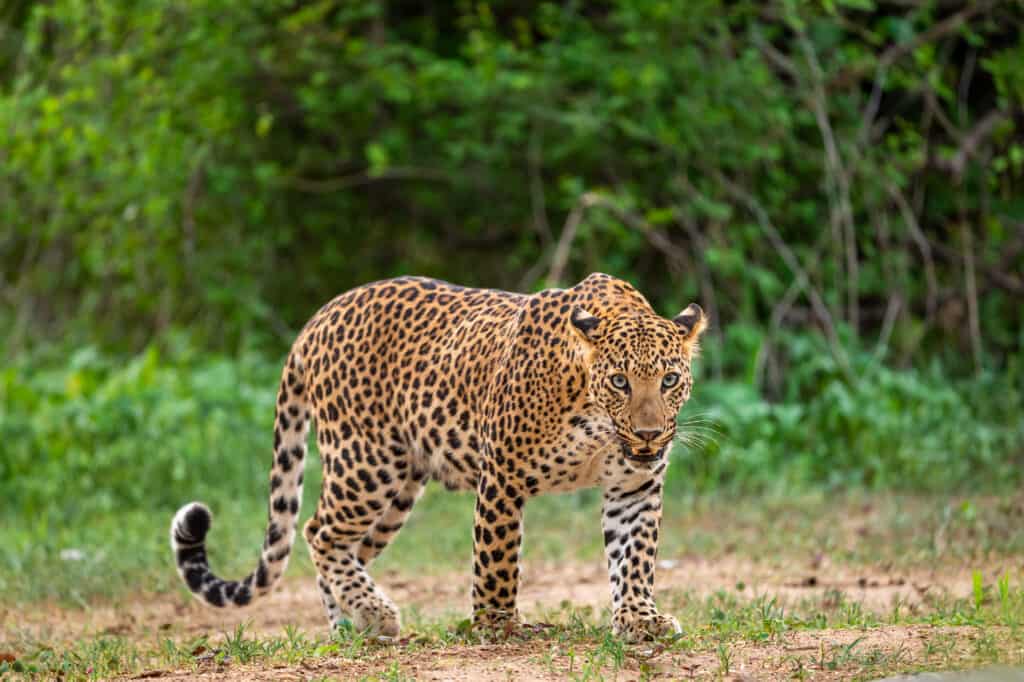
Leopards are felines with spots on their fur.
©Sourabh Bharti/Shutterstock.com
Leopards are felines with spots on their fur. They can be found across savannas because they have a large population distribution. Besides the regular leopard we’ve all been accustomed to, savannas host black panthers, which are melanistic leopards.
Leopards are strong, fast, and light on their feet. They are solitary creatures and only cross boundaries to mate. Leopards aren’t picky eaters and eat anything from bugs to deer.
The leopard’s speed and agility make it an excellent hunter. These felines are also great climbers and love to hang out on trees, where they relax and eat or keep food safe.
2. Elephant
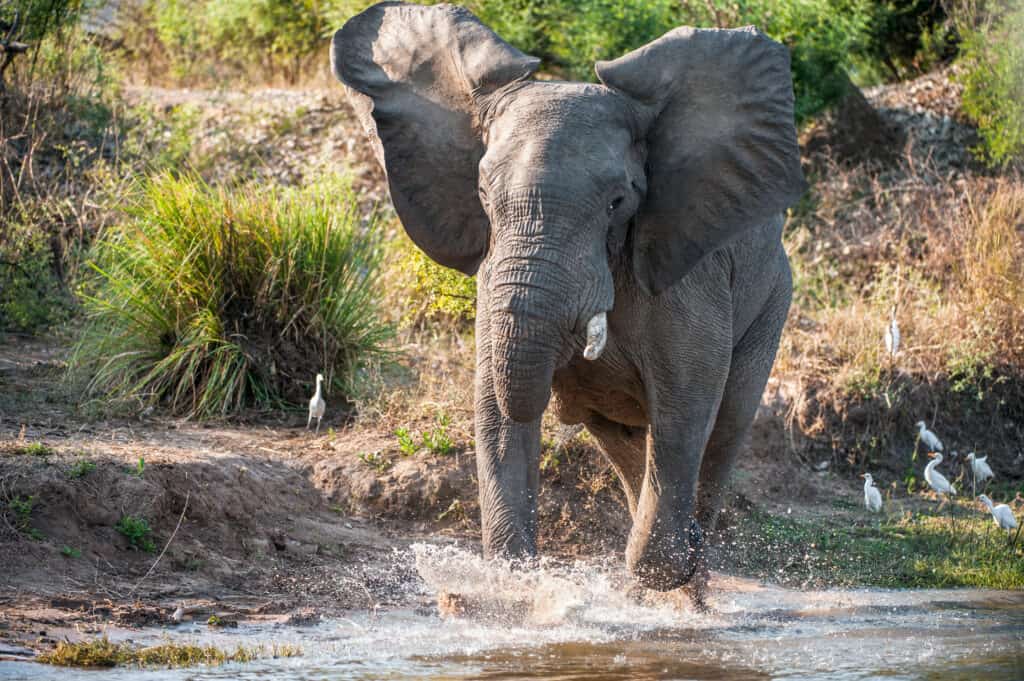
Elephants enjoy a plant-based diet that includes grasses, shrubs, fruits, and even tree bark.
©Sergey Uryadnikov/Shutterstock.com
Elephants are the largest land animals weighing around 6.6 short tons. There are three species of elephants; the African bush elephant, the African forest elephant, and the Asian elephant.
Elephants consume as much as 330 lb (150 kg) of food daily. Elephants enjoy a plant-based diet that includes grasses, shrubs, fruits, and even tree bark.
The elephant’s tusks contain ivory. Unfortunately, this has led to massive elephant poaching. According to the World Wildlife Fund, this led to a significant population drop, and Africa lost 90% of its elephants.
3. Caracal
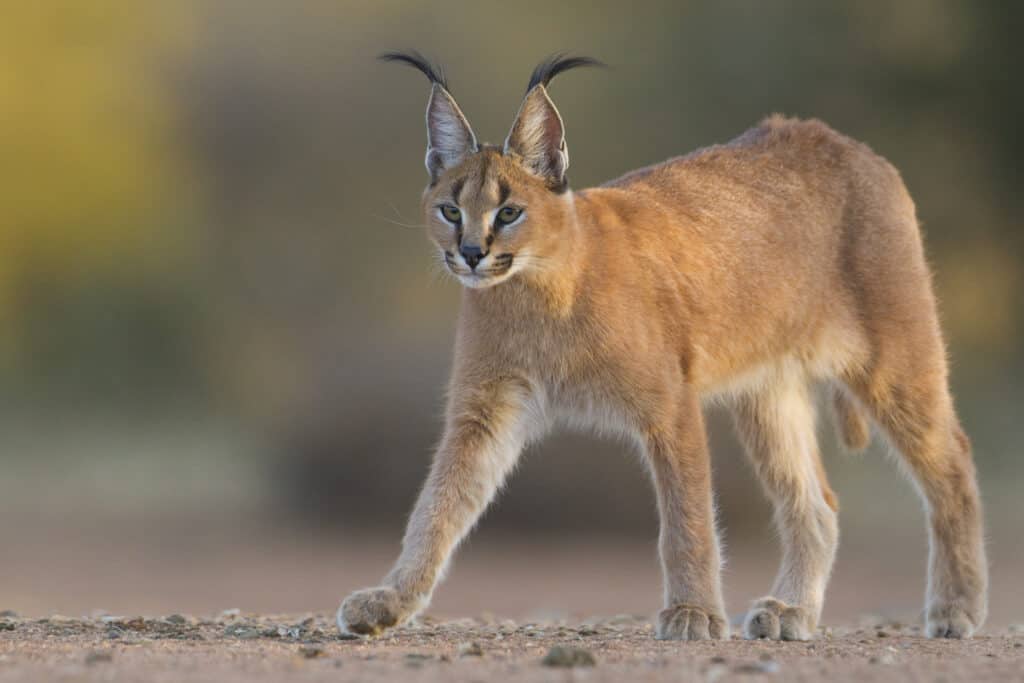
Caracals are sometimes confused with lynxes because of their tufted ears.
©iStock.com/StuPorts
Caracals are wildcats native to parts of Africa, India, Pakistan, and a few places in the Middle East. There are three subspecies of caracals: the northern caracal, the southern caracal, and the Asiatic caracal.
In ancient Egypt, they were domesticated, while Persia and India used them for coursing. These feline creatures are nocturnal and are also excellent hunters.
Because of their tufted ears, caracals are sometimes confused with lynxes. But the absence of spots on their fur is a clear distinction. Caracals are carnivores, and just like leopards, they prefer spending time alone and are rarely seen with other caracals.
4. Kudu

Kudus belong to the
Tragelaphusgenus, also called the spiral-horned antelope.
©yykkaa/Shutterstock.com
Kudus belong to the Tragelaphus genus, also referred to as the spiral-horned antelope. There are two kudu species, with the adult male of the larger species standing over 1.5 meters tall. Both species are native to Africa.
Kudus hide in thick bushes to evade predators. Their brown fur and white stripes make it easy for them to blend into their environment. Their horns, on the other hand, stand out. They have horns that can measure as long as 1.2 m (120 cm) if straightened.
According to the African Wildlife Foundation, the kudu population is rapidly dwindling and, thus, has been listed as near threatened.
5. Hippopotamus

The hippopotamus is considered one of the world’s most dangerous animals because of its aggressive behavior.
©Karel Bartik/Shutterstock.com
The hippo is a semiaquatic mammal that inhabits sub-Saharan Africa. It’s considered one of the world’s most dangerous animals because of its aggressive behavior.
Interestingly, hippos are not as territorial when they come on land to graze as they are in the water. While hippos love spending time in the water, they aren’t very good swimmers.
Because of their size, hippos can walk underwater and use their weight to bounce off the bottom of the river. They can also hold their breath underwater for up to five minutes.
6. Rhinoceros
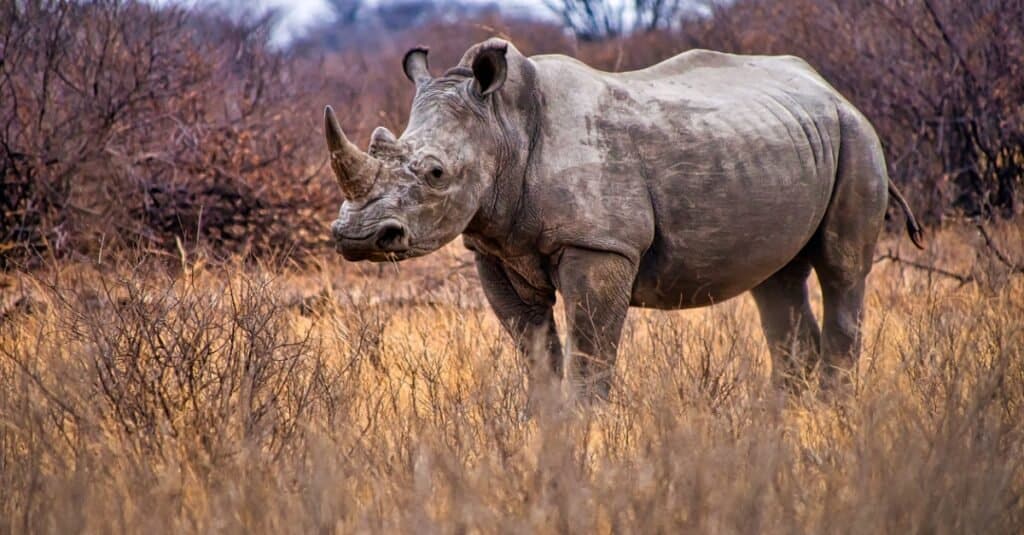
Rhinoceroses have thick but sensitive skin that reacts negatively to sunburns and insect bites.
©iStock.com/Alberto Carrera
There are five rhinoceros species, and two are native to Africa. The other three are found in India and other parts of Asia.
Rhinos are herbivorous animals. Like hippos and elephants, rhinoceroses can reach incredible sizes. A fully developed adult weighs more than 3 – 4 short tons. However, despite their bulky bodies, rhinos can outrun most humans in a race.
Rhinos have thick but sensitive skin that reacts negatively to sunburns and insect bites. To prevent insect bites, they allow oxpeckers to climb on their backs to feed on the pesky insects.
Rhinos are famous for many things, their horns being by far their most popular trait. The massive illegal horn trade led to some species becoming critically endangered.
7. Blue Wildebeest
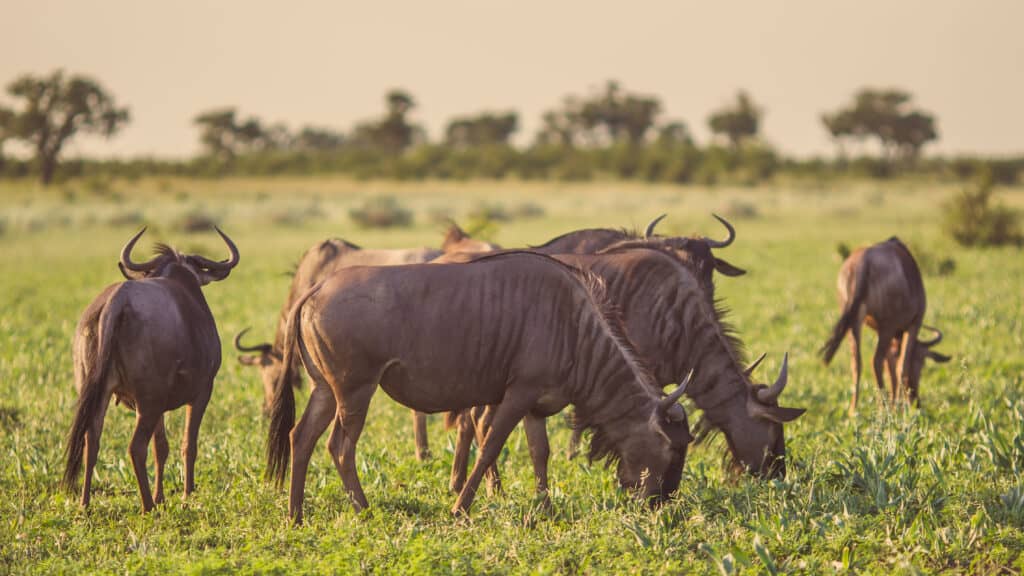
The blue wildebeest is a large antelope native to Africa’s southern and eastern parts.
©iStock.com/CreativeNature_nl
Blue wildebeests are large antelopes native to Africa’s southern and eastern parts. The savanna lands of Eswatini, Kenya, Tanzania, and a few others are home to these magnificent creatures. They get their name from their coat color. Depending on the season, it ranges from grayish blue to silvery blue. There have been rare sightings of their blueish coat having a luminescent glow during the change of season.
As herbivores, blue wildebeests graze on grass. Whenever the dry season comes in, these animals migrate long distances in search of green pastures.
8. African Buffalo
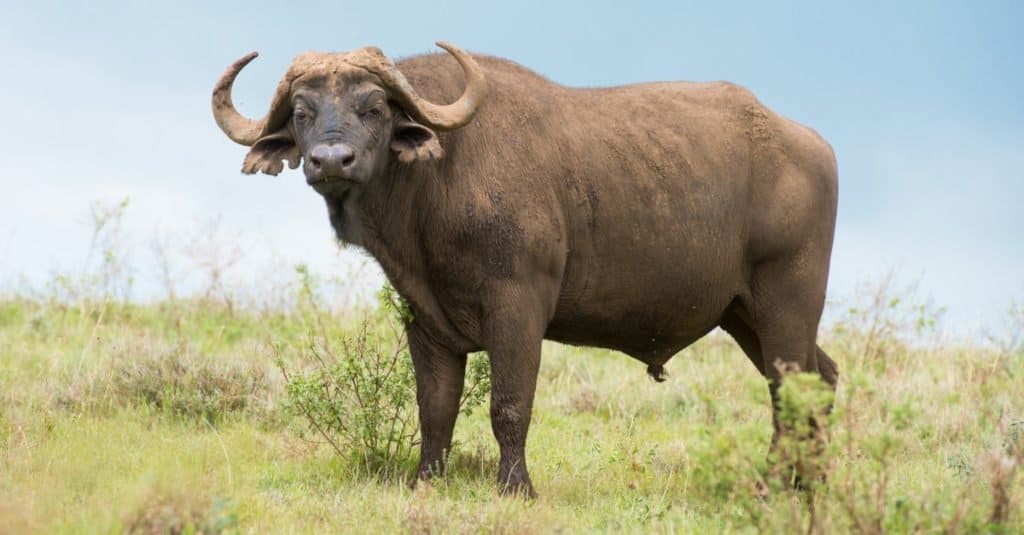
The African buffalo is a large bovine animal.
©BonnieBC/Shutterstock.com
The African buffalo is a large bovine animal. Although it looks strikingly similar to a bull (the cattle species), the two are different species.
Surprisingly, African buffaloes are not domesticated like their Asian peers, the water buffalo. That is because they are unpredictable. When incensed, they use their strength to attack. There are over 200 buffalo-related deaths reported annually.
The size of the African buffalo makes it a hunting prize for those who indulge in the sport. Apart from humans, predators like lions, hyenas, and crocodiles hunt buffaloes. But these beasts give as good as they get. Sometimes, it takes a pack of lions to bring down an adult buffalo.
9. Steenbok
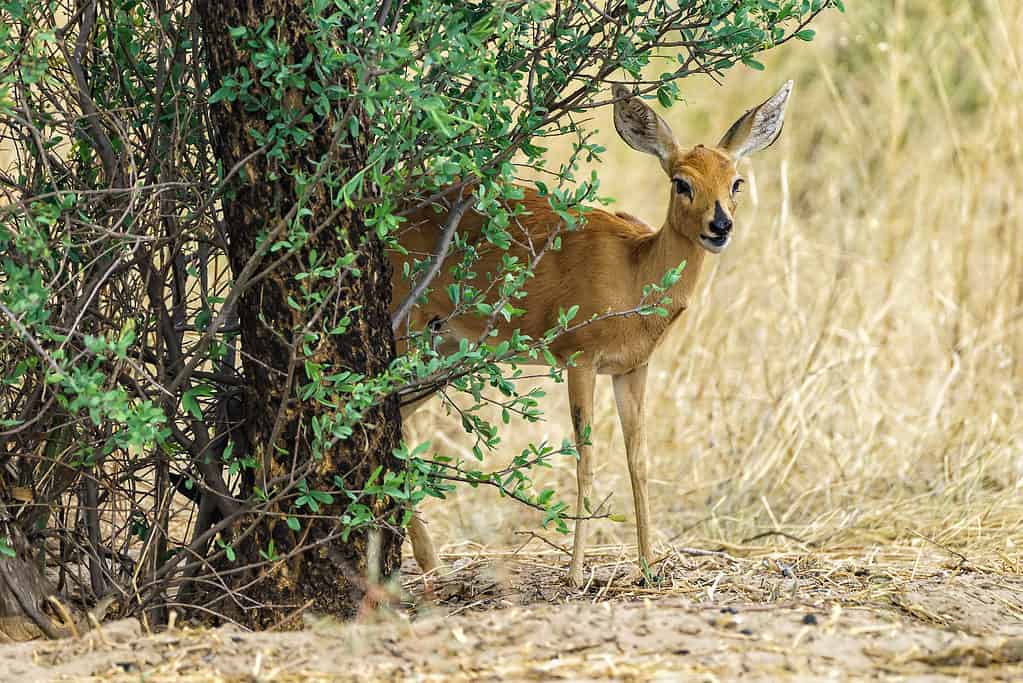
Steenboks possess excellent eyesight, keen hearing, and strong instincts.
©iStock.com/Wirestock
The steenbok is another species of antelope native to African savannas. It’s a small species and, as a result, has a lot of predators. To give itself a fighting chance, the steenbok likes to graze among thick, tall grasses that mask its presence.
Steenboks also have an evasive running maneuver that confuses the predator chasing them. These antelopes will stay still or lie low in the vegetation if running isn’t required.
Steenboks possess excellent eyesight, keen hearing, and strong instincts. As fragile as they look, they have strong survival skills. Moreover, they can survive for long periods without water because they get all the required liquids from what they eat.
10. Gazelle

Gazelles can maintain high-speed levels for longer.
©iStock.com/StuPorts
Gazelles are the last antelopes we will discuss in this article. The African savannas and some regions in South and Central Asia are native homes of these exquisite animals.
The beauty and grace of the gazelle hide the strength that they possess. While gazelles cannot outrun some of their predators, they do, however, outmaneuver them in a chase. Their high level of endurance plays to their advantage. Gazelles can maintain high-speed levels for longer – something that one of their chief predators, the cheetah (which also happens to be the fastest land animal on the planet), can’t.
11. Jackal

Jackals are canine animals the size of domestic dogs.
©Robert Henry Hurn/Shutterstock.com
Jackals are canine animals the size of domestic dogs. They are relatives of coyotes, wolves, and foxes. In appearance, they look like a mix between a German shepherd and a fox.
Jackals are omnivores; they enjoy both plants and meat in their diet. There are three known jackal species, indigenous to Africa, the Middle East, and Asia. Several savanna regions on the African continent have recorded at least one species.
Each jackal species has a different color pattern. There are also behavioral traits that set them apart. For example, the side-striped jackal is strictly nocturnal. This species also enjoys living in wetter parts of the savanna.
12. Rock Python
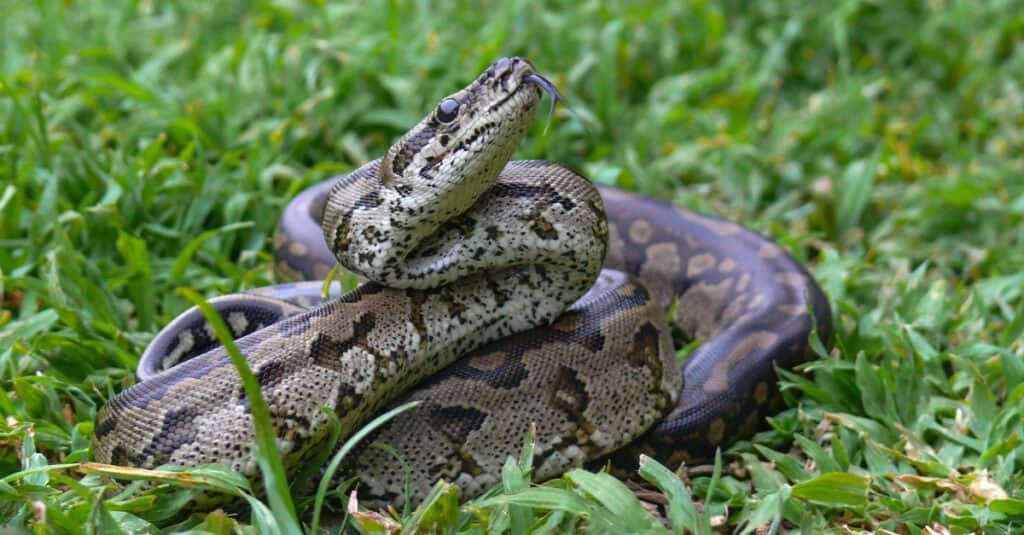
Rock pythons can grow as long as 20 feet.
©Chris Graf/Shutterstock.com
African rock pythons are non-venomous snakes native to Africa. They kill their prey by using their body to constrict and cut off the air supply.
These snakes live around rocky areas, but you can always find them patrolling areas close to small bodies of water where they can hunt for their favorite prey; the waterfowl.
Rock pythons can grow as long as 20 feet. Although they are slender, their jaws can expand considerably to accommodate the size of the prey they want to swallow.
13. Meerkat

Meerkats are social mammals that live in savannas.
©nattanan726/Shutterstock.com
Meerkats are social mammals that live in savannas. They are socially intelligent, and they have assigned roles and work together to preserve their communities.
Meerkats are carnivores. They survive on a diet that includes bugs, caterpillars, scorpions, and the eggs of other smaller birds and animals. The terrain where meerkats live comes with predators and geographical threats such as droughts or flooding.
Despite their small stature, meerkats are sturdy animals. They have immunity against most snake venoms. They have also mastered the art of handling scorpions so that they can safely eat them without suffering from the effects of the creature’s venom.
14. Giraffe
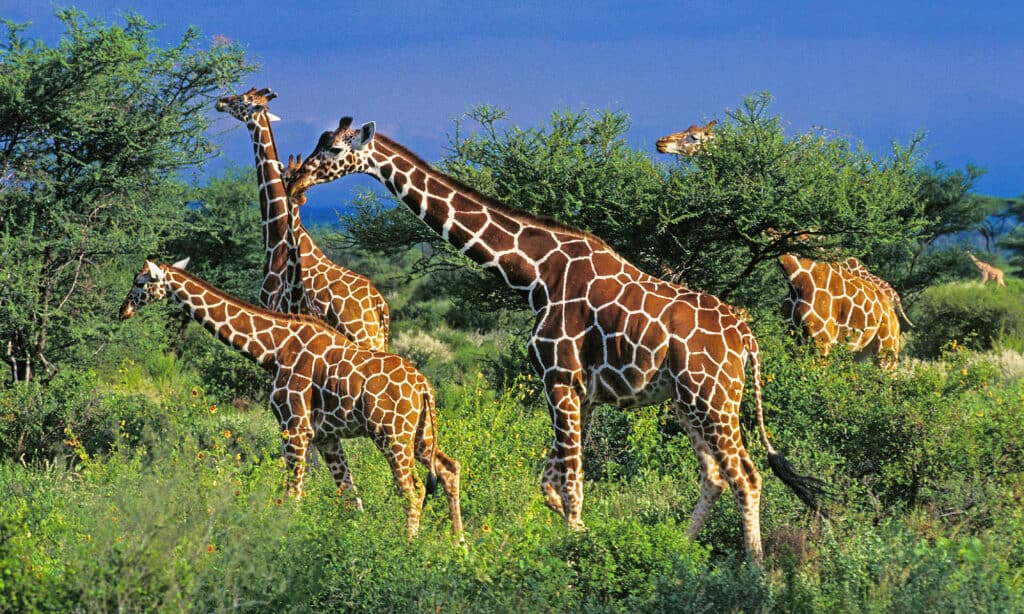
Giraffes are famous for their long necks and spotted fur.
©iStock.com/slowmotiongli
Giraffes are the tallest mammals on Earth; even a newborn giraffe is taller than most humans. They are close relatives to the okapi, who inhabit the northeastern Congo. Giraffes are famous for their long necks and spotted fur. Interestingly, just as no two human beings have the same fingerprints, no two giraffes have the same patterns on their fur. These tall herbivores grace the savannas of Central and South Africa.
Giraffes eat plants’ leaves, fruits, and flowers, especially those at the top of the tree. You can also find them awkwardly spreading their long legs to bend and graze on grass.
15. Lion
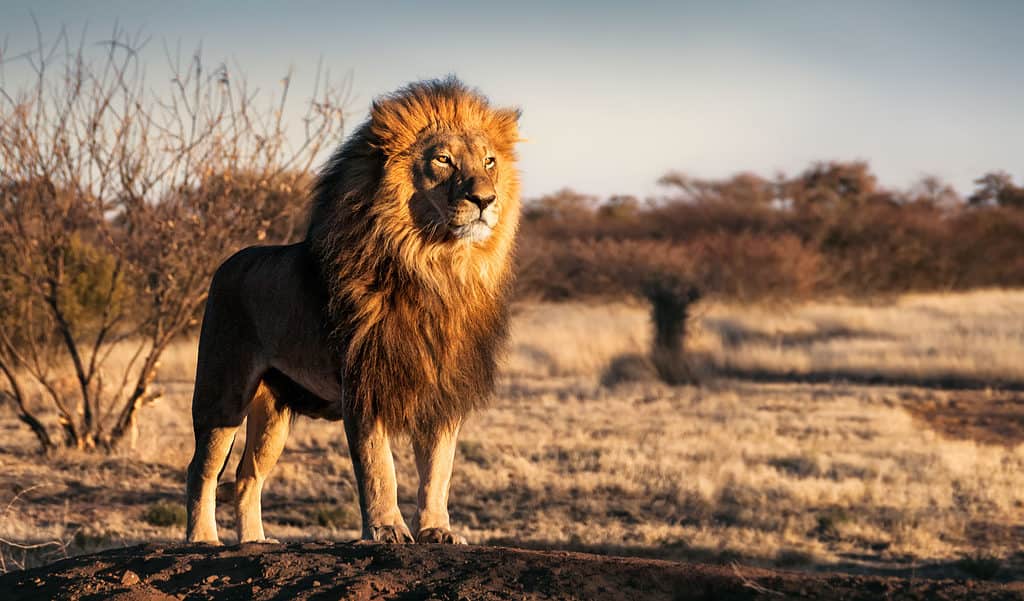
Lions are the second-biggest cats after
Siberian
tigers.
©2021 Photography/Shutterstock.com
The king of the jungle is the pride and heart of Africa. Lions are the second-biggest cats after Siberian tigers, and they are as ferocious as they are lazy. Lions are known to spend 20 hours a day sleeping, but when they hunt, they do so with precision. Females usually hunt, while males ensure that outside threats and competition stay out of their territories.
Contrary to folklore, lions don’t live in jungles. They call the African savannas home. Lions once existed in countries like Greece, Turkey, and Bulgaria. Today, India is the only country outside Africa that has lions.
16. Hyena
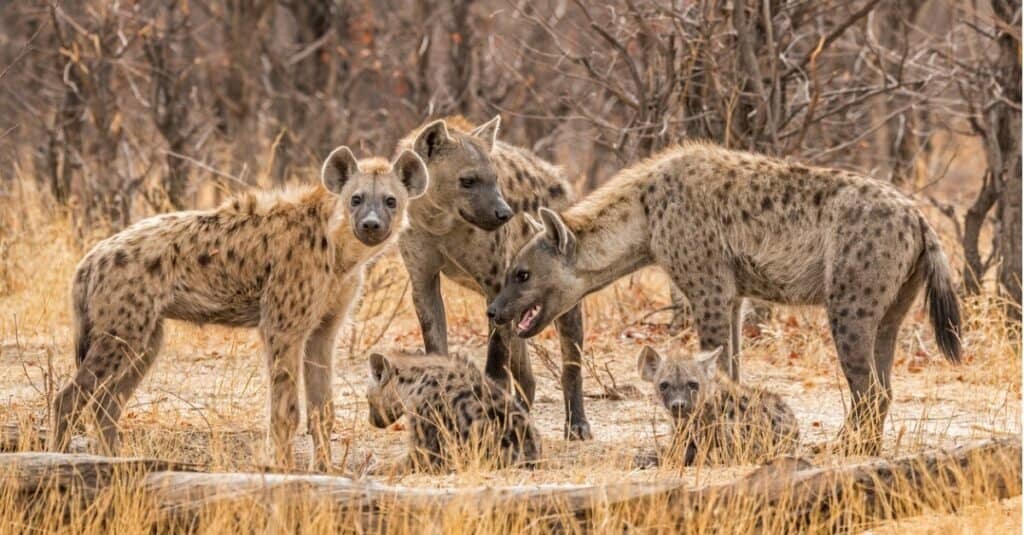
Hyenas are the most common carnivores in Africa.
©iStock.com/Franz Schallmeiner
Hyenas are the most common carnivores in Africa. You’ll find hyenas in savannas throughout the African continent. From the northern part of the continent to the southern lands, you will find hyenas in the savanna lands.
Although hyenas look like dogs, they are not related. Hyenas have more in common with civets and cats. There are four different species of hyenas. Interestingly, while each species has its own sounds, only the spotted hyenas make the laughing sounds we associate with them.
Hyenas are not picky eaters. Apart from meat, their diet consists of fruits, beetles, frogs, and even grasshoppers. Despite the negative press hyenas receive, attacks on humans are rare.
17. Ostrich

Ostriches are the fastest birds on land.
©iStock.com/slowmotiongli
Ostriches are the fastest birds on land and are famous for their feathers and wings. However, they do not fly. The egg of an ostrich is huge, and no other egg-laying creature comes close in size.
Ostriches can be found only in Africa, and there are two extant ostrich species: the common ostrich and the Somali ostrich. Ostriches are considered omnivores. They enjoy a diet of plants, roots, lizards, and insects.
What Are Some Interesting Facts About Savannas?
Savannas can be found on most continents. They are a made up of a mixture of trees and shrubs. Since the trees are tall and separated enough to let sunlight in, grass and bushes are able to thrive. The most famous savannah, the Serengeti in Africa, hosts the largest animal migration, with approximately 2 million animals migrating in a clockwise direction in search of food. Another interesting fact about savannas is that the oldest human remains were found in the Serengeti at an archaeological site known as Olduvai Gorge. These ancient ancestors used stones for tools, and animal bones show marks, suggesting these early humans were meat-eaters. Sadly, savannas around the world are threatened by humans and global warming. The delicate ecosystem is affected by deforestations, poaching, and drastic changes in seasonal temperatures.
Summary of 17 Animals That Live in the Savanna
| Number | Animals |
|---|---|
| 1 | Leopard |
| 2 | Elephant |
| 3 | Caracal |
| 4 | Kudu |
| 5 | Hippopotamus |
| 6 | Rhinoceros |
| 7 | Blue Wildebeest |
| 8 | African Buffalo |
| 9 | Steenbok |
| 10 | Gazelle |
| 11 | Jackal |
| 12 | Rock Python |
| 13 | Meerkat |
| 14 | Giraffe |
| 15 | Lion |
| 16 | Hyena |
| 17 | Ostrich |
The photo featured at the top of this post is © Vova Shevchuk/Shutterstock.com
Sources
- World Wide Fund for Nature, Available here: https://www.wwf.org.uk/learn/fascinating-facts/elephants
- World Animal Protection, Available here: https://www.worldanimalprotection.us/blogs/10-interesting-facts-know-about-hippos
- Sabi Sabi, Available here: https://www.sabisabi.com/wildfacts/steenbok/
- Treehugger, Available here: https://www.treehugger.com/gazelle-facts-5084065
Thank you for reading! Have some feedback for us? Contact the AZ Animals editorial team.






